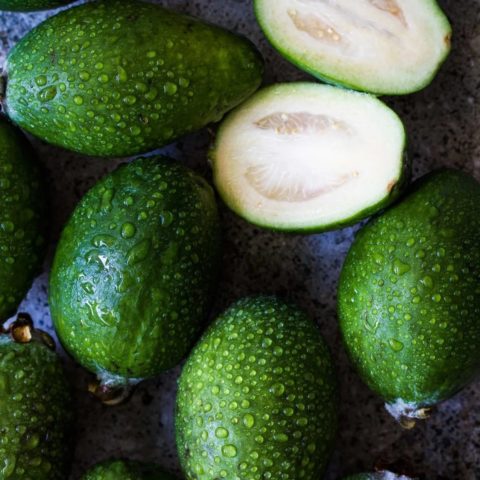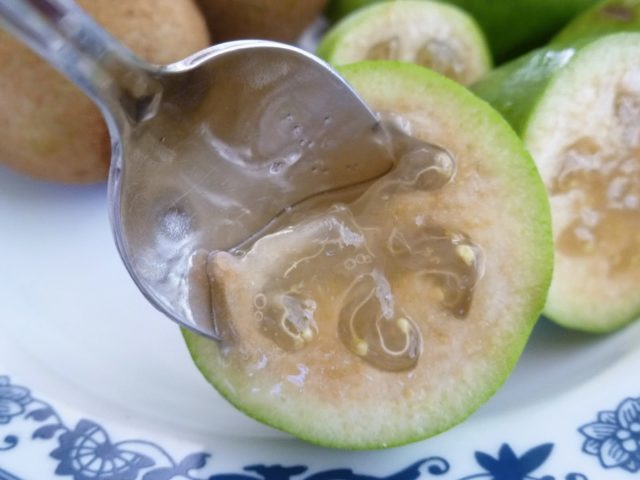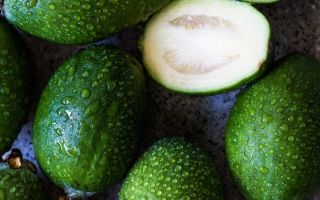Content
Feijoa when breastfeeding is not prohibited. It contains a lot of nutrients necessary for the proper development of the baby. But the introduction of the product into the diet has some nuances. During lactation, they should be taken into account.
Is it possible to eat feijoa for nursing mothers
Feijoa has a high nutritional value and exotic taste. On the territory of the Russian Federation, it grows in the Krasnodar Territory, Crimea, Abkhazia, Georgia and Azerbaijan. She is the fruit of an evergreen tree of the Myrtle family. With the help of the fruit, you can make the diet for breastfeeding more varied and healthy. In addition, 100 g contains only 55 kcal. The product is quickly digested and rarely causes negative reactions in the body. It normalizes the thyroid gland and replenishes the vitamin and mineral reserves in the body. Feijoa is not prohibited for breastfeeding women, but it must be consumed in strictly limited quantities. Only in this case will it benefit the baby.
Feijoa composition and value
Feijoa is a real storehouse of nutrients for women during breastfeeding. In terms of iodine content, it can easily compete with seafood. There are 3 mg of substance per 100 g of fruit. At the same time, it is absorbed better than drugs. Iron is present in it in almost the same amount as in pomegranate. The fruit also has a powerful immunomodulatory effect due to its vitamin C content. For this reason, doctors recommend using it during the cold and flu season. This is especially true while breastfeeding. The mineral composition of feijoa is represented by the following components:
- phosphorus;
- iodine;
- potassium;
- zinc;
- iron;
- magnesium;
- manganese;
- sodium;
- copper.

The product is also famous for being rich in amino acids and unsaturated fats. The latter affect the synthesis of hormones, and prevent the process of deposition of harmful cholesterol. Thanks to essential oils and antioxidants, the product cleanses the digestive system of toxins and toxins. The organic acid content maintains the electrolyte balance in the body. The vitamin composition is represented by the following components:
- vitamin C;
- thiamine;
- riboflavin;
- a nicotinic acid;
- vitamin B5;
- adermin;
- folic acid.
A surprising feature of the fruit is its high potassium content and low sodium content. This distinctive feature has a relaxing effect on blood vessels, which helps maintain blood pressure at the required level. During breastfeeding, it helps to improve the woman's well-being.
Why is feijoa useful for nursing mothers
Feijoa with HB can be used if only because it is rich in pectin and fiber. Due to their content, the work of the digestive system is regulated.Essential oils, in turn, give vigor and improve mood, which is important during the lactation period. Pectins provide full bowel function, relieving constipation. Ascorbic acid, present in the composition, reduces the risk of developing inflammatory processes characteristic of the postpartum period.
The useful properties of feijoa also include:
- strengthening of the vascular walls;
- restoration of the urinary system;
- strengthening of immunity;
- relief of the inflammatory process;
- prevention of the formation of cholesterol plaques;
- improved blood composition;
- prevention of gastrointestinal diseases.
In some cases, feijoa is introduced into the diet for therapeutic and prophylactic purposes. It is indicated for use in violation of the thyroid gland due to a lack of iodine. Equally effective is the treatment and prevention of iron deficiency anemia. When breastfeeding, it can be an excellent alternative to drugs that are prohibited during this period.
It also has a positive impact on the development of the child. Getting into the baby's body along with milk, feijoa activates mental activity and strengthens the immune system. Due to the content of leukoanthocyanins, the product provides protection against harmful environmental influences. Unlike many other fruits and berries, feijoa is low in allergens. This means that the likelihood of developing adverse reactions in a child is very small.
Rules for introducing feijoa into the diet of a nursing mother
Feijoa can be eaten while breastfeeding only if the baby is three months old. It is necessary to make sure that there is no allergic reaction in the baby. For this purpose, the product is introduced into the diet gradually. Eat ¼ of the fruit first. If the baby does not have an allergic reaction, you can continue to use the product. Skin rashes are an important reason for avoiding feijoa.
Other unpleasant symptoms of intolerance include:
- difficulty breathing;
- colic in the abdomen;
- vomiting;
- wheezing;
- increased body temperature;
- swelling of mucous surfaces.
Terms of use
Experts advise eating feijoa during breastfeeding exclusively in the first half of the day. In this case, it is absorbed much faster. Before use, the pulp is cut into pieces or eaten with a spoon. The second option is considered the most convenient.

How much can you eat feijoa for nursing mothers
During breastfeeding, it is recommended to consume no more than 150 mg per day. This amount is enough to replenish the supply of nutrients without harming the baby's health.
How to use
When breastfeeding, fruits are most often eaten fresh. They can also be crushed to a mushy state and mixed with honey or sugar. But in this case, the risk of developing allergies increases. Feijoa is often used to make stewed fruit, jam or smoothies. It goes well with cottage cheese, berries and fruits. Before fresh consumption, the fruit is peeled.
Limitations and contraindications
Feijoa should be used with caution, considering contraindications and restrictions. Otherwise, you may face an allergic reaction or digestive upset in the child.
Fruit should not be eaten while breastfeeding in the following cases:
- allergic reaction;
- chronic constipation;
- thyroid disease;
- diabetes.
If the child is prone to an allergic reaction, the fruit should be eaten with breastfeeding in strictly limited quantities, observing the baby's health. If suspicious symptoms occur, the diet needs to be adjusted.
Selection and storage rules
To avoid food poisoning, you should pay special attention to the selection of the fruit. In overripe, the fermentation process begins. The ripeness of a product is judged by the appearance of the peel. It should be moderately soft, whole and have a deep green hue. The brown color of the flesh indicates that the fruit is not suitable for breastfeeding. If the fruits have mechanical damage or dents, it is strictly forbidden to eat them. It is believed that large specimens have the most pronounced taste, so it is advisable to buy them.
The storage principle depends on the ripeness of the fruit. Unripe fruits have a long shelf life. If the harvest was carried out in late autumn, then the fruit will be perfectly preserved until spring. To speed up the ripening process, simply place the product in a ventilated room with a temperature of 21-24 ° C. In such conditions, it will mature in a week. Ripe fruits spoil within a few days. They must be stored in a special compartment of the refrigerator. The longer the fruit lies, the sweeter it becomes. Feijoa jam can be stored for several years. Over time, its color may change to brown. This is considered completely normal.
Conclusion
Feijoa while breastfeeding can be an excellent addition to the daily diet. It is important not to abuse it and take into account contraindications. It is advisable to consult a breastfeeding specialist before introducing a product into the diet.

